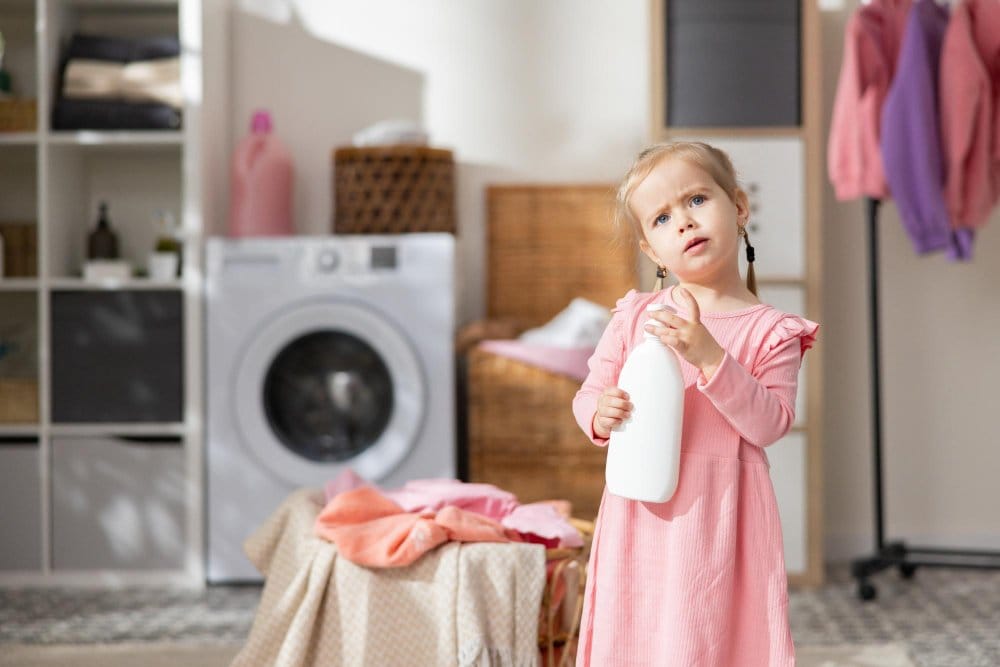Expert Guide to Safe Family Laundry: Protecting Your Toddler’s Sensitive Skin
You can safely wash toddler clothes with adult laundry when using gentle, fragrance-free detergent suitable for sensitive skin. This simple change can save busy parents significant time while keeping children’s clothes clean and safe. However, understanding the right approach is crucial for protecting your child’s delicate skin and ensuring proper hygiene.
Most pediatric dermatologists and the American Academy of Pediatrics support combining loads when proper precautions are taken. The key lies in choosing appropriate products and following smart laundry practices that prioritize your toddler’s wellbeing.
Table of Contents
Understanding the Safety of Mixed Laundry Loads

Expert Recommendations on Combined Washing
Healthcare professionals generally agree that washing toddler and adult clothes together is safe when parents use mild, hypoallergenic detergents. The American Academy of Pediatrics emphasizes that families with young children spend considerable time doing laundry, making proper safety precautions essential. Pediatricians often recommend products labeled “free and clear” to minimize skin irritation risks.
The main guideline involves avoiding heavily soiled work clothes or sports gear when washing with toddler items. If someone in the household is sick or has a skin condition, washing their clothes separately provides extra protection. Otherwise, for families without allergies or special skin conditions, combining laundry loads works well.
Some experts suggest using an extra rinse cycle to remove any leftover detergent residue. Washing in warm or hot water effectively kills most bacteria and germs, making mixed-family laundry safe for everyone.
Common Parent Concerns About Mixed Loads
Many parents worry that combining toddler clothes with family laundry could cause increased wear and fading of smaller items. Toddler clothing often features softer fabrics that can be more delicate than adult garments. Parents also express concern about sharing bacteria, dirt, or allergens that might transfer from adult clothing.
Some families fear that detergent residue on adult laundry could irritate a toddler’s sensitive skin, especially when using strong detergents or fabric softeners. This concern becomes particularly important for children with allergies or eczema.
On the positive side, washing everything together saves considerable time and energy. This approach works best when laundry isn’t heavily soiled and when families use gentle, fragrance-free detergents suitable for sensitive skin.
Potential Risks and Safety Considerations
When washing toddler clothes with adult laundry, there are several important considerations that parents should understand to protect their child’s health and comfort.
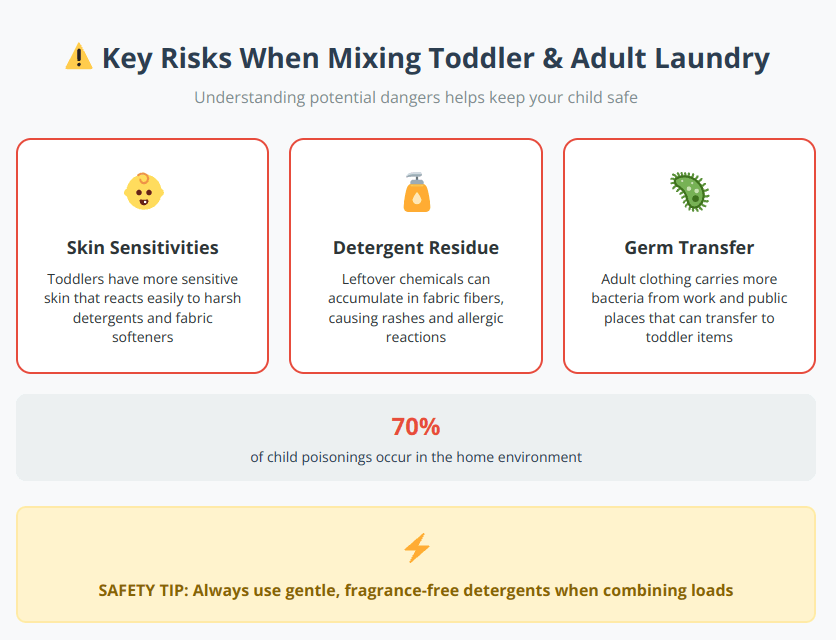
Understanding these potential risks helps parents make informed decisions about their family’s laundry routine and take appropriate precautions.
Skin Sensitivities and Allergic Reactions
Toddlers typically have more sensitive skin than adults, making them more susceptible to reactions from harsh detergents, soap residues, or fabric softeners that don’t affect older family members. Young children are also more likely to develop rashes or allergies from certain chemicals found in standard laundry products.
When parents use strong detergents or fragranced products on their own clothes, these chemicals can transfer to children’s laundry during combined washing. This transfer means toddler skin could come into contact with residues or chemicals designed for adult clothing, potentially causing itching, redness, or rashes.
Important Note: If your child already has sensitive skin or known allergies, consider avoiding combined loads or switching to a gentle, fragrance-free detergent for the entire family.
Detergent Residue Concerns
Standard detergents don’t always rinse completely from clothing fibers. When washing thick adult items like jeans or sweatshirts with lightweight toddler clothes, leftover detergent can accumulate in fabric fibers.
This residue buildup means toddler clothes could end up with more detergent remnants, especially when using excessive amounts or products with strong chemicals and fragrances. Some laundry products are formulated specifically for adult needs and aren’t intended for children’s clothing.
Risks of detergent residue include:
- Skin irritation or eczema flare-ups
- Unpleasant odors or fabric stiffness
- Allergic reactions in sensitive children
Parents can reduce these risks by using appropriate detergent amounts, choosing products designed for sensitive skin, and running extra rinse cycles when needed.
Contamination and Germ Transfer
Adult clothing often encounters more germs and dirt from work environments, public places, or exercise activities. While toddler clothes might be messy from food spills or outdoor play, they typically don’t contact the same types of bacteria and germs that adults bring home.
When washing everything together, bacteria from adult clothing can transfer to toddler items. This becomes more concerning when someone in the home is ill or when clothes are soiled with potentially harmful substances.
Watch for these situations:
- Clothing exposed to illness
- Work uniforms or gym clothes
- Items with bodily fluid contamination
In these cases, separate washing helps reduce the risk of spreading germs to toddlers or other family members.
Critical Laundry Room Safety for Families
Creating a safe laundry environment requires understanding the serious risks that household products pose to young children and implementing proper safety measures.
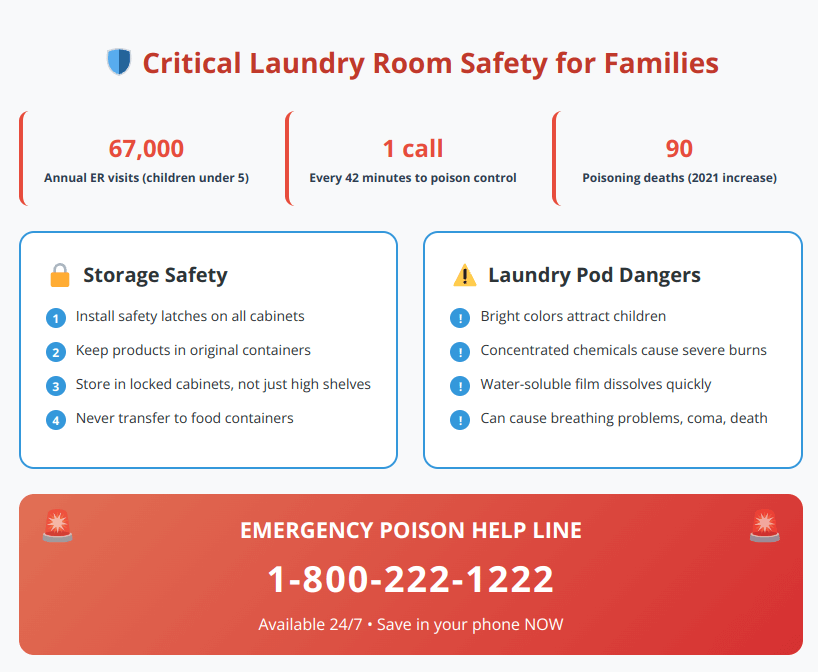
These safety measures are crucial for preventing the thousands of annual emergency department visits and protecting children from serious harm.
Poison Prevention in the Laundry Area
The U.S. Consumer Product Safety Commission reports that nearly 70% of child poisonings occur in the home, with approximately 67,000 emergency department visits annually for children under 5. Unintentional pediatric poisoning deaths of children under age 5 increased about 53% to 90 from 2021. The laundry room presents particular dangers that parents must address.
Essential Safety Measures:
- Install safety latches on all cabinets containing cleaning products
- Keep all detergents in original containers with child-resistant caps
- Store products in locked cabinets, not just on high shelves
- Never transfer detergents to food containers or unlabeled bottles
Laundry Pod Dangers
Children under 3 account for most laundry detergent packet exposures. Poison control centers receive one call every 42 minutes about young children exposed to detergent packets, with one child hospitalized every 42 hours from these incidents.
Why pods are dangerous:
- Bright colors attract children who mistake them for candy
- Concentrated chemicals can cause severe burns
- Water-soluble film dissolves quickly when wet
- Even small amounts can cause breathing problems, coma, or death
Safer alternatives for families with young children:
- Use traditional liquid or powder detergents
- If using pods, store them in original containers with secure lids
- Consider switching until children are older
Emergency Preparedness
Every parent should know the National Poison Help Line: 1-800-222-1222. This number connects to local poison control centers 24/7 for immediate assistance.
Stay organized and ensure you never miss important safety steps with our Printable Family Laundry Safety Checklist. Post it in your laundry room as a daily reminder of essential safety practices.
Emergency symptoms requiring immediate medical attention:
- Difficulty breathing or swallowing
- Severe coughing or throat pain
- Persistent vomiting
- Chemical burns on skin or in mouth
- Loss of consciousness
The American Cleaning Institute emphasizes the importance of teaching young children that laundry products and their containers are not toys. Families should familiarize themselves with product labels and know where safety information is located before any unintended exposure happens.
Choosing the Right Detergent for Mixed Loads

Top-Rated Baby-Safe Detergent Options
Based on 2025 testing and dermatologist recommendations, here are the most effective options for families washing toddler and adult clothes together:
| Detergent | Price per Load | Key Features | Best For |
|---|---|---|---|
| Babyganics Liquid Baby Detergent | $0.35 | Plant-based, removes food/formula stains | Newborns to toddlers |
| Tide Free & Gentle | $0.28 | Hypoallergenic, widely available | Whole family use |
| Seventh Generation Free & Clear | $0.31 | 96% bio-based, eco-friendly | Environmentally conscious families |
| Puracy Natural Laundry Detergent | $0.42 | Highly concentrated, refillable | Budget-conscious parents |
| Method Free + Clear | $0.36 | 4X concentrated, recycled packaging | Space-saving storage |
Benefits of Baby-Specific Detergents
Baby detergents are specifically formulated to be gentler and less likely to cause skin irritation. These products typically exclude dyes, fragrances, and harsh chemicals that could trigger reactions in sensitive skin.
Advantages of baby detergents:
- Formulated specifically for delicate or sensitive skin
- Free from strong scents and artificial dyes
- Designed to handle common children’s stains like food and dirt
- Safe for entire families when members have skin sensitivities
Some regular detergents can leave residues that may irritate toddler skin. Choosing baby detergent helps avoid these concerns while still effectively cleaning all family laundry.
Not sure if your current detergent is safe for your toddler? Use our Detergent Ingredient Checker Tool to instantly analyze any laundry detergent’s ingredients for baby safety.
Hypoallergenic and “Free & Clear” Options
Hypoallergenic detergents offer excellent choices for families wanting to wash toddler and adult clothes together. These products are designed to reduce allergic reactions and are often labeled as “free and clear.”
Look for these features in hypoallergenic detergents:
- No artificial fragrances or added scents
- No synthetic colors or dyes
- Dermatologist-tested or labeled “safe for sensitive skin”
- Easy rinse formulation that removes completely from fabrics
Using hypoallergenic products allows parents to do less sorting because they’re gentle enough for everyone. This saves time while keeping toddler skin safe. For families with members who have skin problems, always check labels for these qualities before purchasing.
Best Practices for Safe Family Laundry
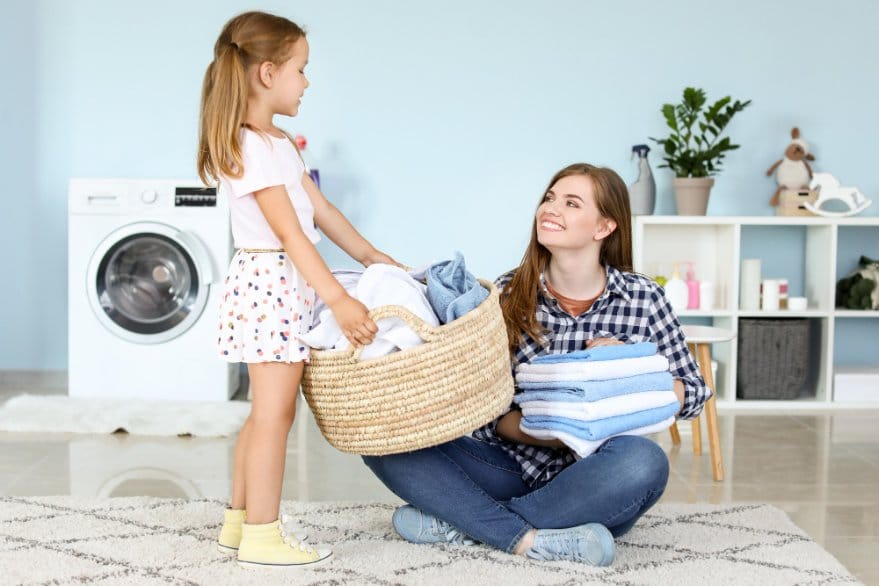
Proper Sorting Techniques
Start by sorting all clothes before loading the washing machine. Use separate laundry baskets or a divided hamper for whites, colors, and delicates. This prevents color transfer and helps manage different fabric care needs.
Heavily soiled toddler clothes with food or bodily fluids should go in separate loads to prevent contamination of other items. Check all pockets for tissues, small toys, or other objects that toddlers often hide in their clothing.
For families with members who have allergies or sensitive skin, designate specific items for gentle or fragrance-free detergent washing. Regular sorting makes it easy to manage different washing needs without confusion.
Optimal Washing Settings and Techniques
Choose a detergent that is free from dyes and perfumes, such as products labeled “free and clear.” This helps protect sensitive skin, especially for toddlers and family members with skin sensitivities.
Wash toddler and adult clothes in warm or cold water for most loads. Use hot water only for tough stains or when someone in the household is sick and extra sanitization is needed. Select gentle cycles for delicate fabrics and normal cycles for towels and denim.
Best practice tips:
- Never use excessive detergent amounts – follow bottle recommendations
- Consider double-rinsing toddler items to remove soap residue
- Use mesh laundry bags for small socks and accessories
- Pre-treat stains promptly for best results
Take the guesswork out of mixed family loads with our Laundry Load Size Calculator. Get personalized recommendations for detergent amounts and wash settings based on your specific mix of baby and adult clothes.
Drying and Post-Wash Handling
After washing, move clothes promptly to the dryer or hang them to dry. Always check clothing tags for specific drying instructions, as some items may require air drying.
Use low or medium heat settings in the dryer for most clothes to prevent shrinking and fabric damage. Pay extra attention to toddler clothes, hanging up items that might be sensitive to heat, such as clothes with prints or delicate fabrics.
Once dry, sort clean laundry into separate baskets for each family member. This helps maintain organization and can even encourage toddlers to help put their clothes away, building good habits early.
Special Washing Situations and Guidelines
Certain items require special handling to ensure proper hygiene and safety when caring for toddler clothing and accessories.
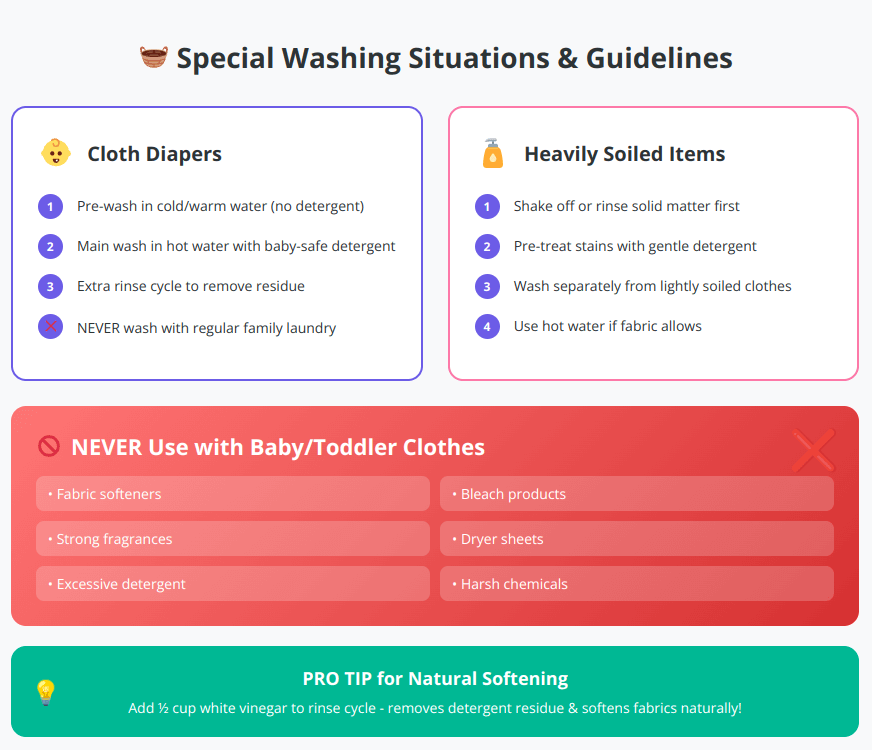
Following these specialized washing procedures helps maintain proper hygiene while protecting your toddler’s sensitive skin from harsh chemicals.
Cloth Diapers and Heavily Soiled Items
Never wash cloth diapers with regular family laundry. Cloth diapers require separate washing because they can carry bacteria and strong odors that shouldn’t transfer to other clothing items.
Cloth diaper washing routine:
- Pre-wash in cold or warm water without detergent
- Main wash in hot water with baby-safe detergent
- Extra rinse cycle to remove all detergent residue
Avoid using fabric softener or bleach with cloth diapers, as these products can irritate children’s skin or damage the diaper materials.
For heavily soiled toddler clothes, shake off or rinse solid matter before placing items in the washer. Pre-treat tough stains with gentle detergent or child-safe stain remover. When items are especially dirty, wash them separately to prevent stains or bacteria from spreading to lightly soiled clothes.
Struggling to identify a mysterious stain on your toddler’s clothes? Our Stain Identification Quiz helps you identify common baby stains and provides step-by-step treatment instructions for safe, effective removal.
Fabric Softener and Additive Considerations
Avoid using fabric softener when washing toddler clothing. Most experts warn that fabric softeners can irritate young children’s sensitive skin due to chemicals and fragrances in these products.
Fabric softeners can also leave coatings on clothes that make fabrics less breathable. For clothing labeled as flame-resistant, this coating can reduce fire-resistance properties, creating safety concerns for children’s sleepwear.
Safer alternatives to fabric softener:
- Use gentle, fragrance-free detergents only
- Add half a cup of white vinegar to rinse cycle for natural softening
- Choose detergents specifically formulated to leave clothes soft
White vinegar helps remove detergent residue and naturally softens fabrics without adding harsh chemicals that could affect sensitive skin.
Washing Different Fabric Types Together
When washing cotton and synthetic fabrics together, consider the care requirements for each material. Cotton typically handles higher temperatures, while synthetic materials may require gentler treatment.
Tips for mixed fabric loads:
- Use warm water as a compromise temperature
- Choose gentle or normal cycles based on the most delicate items
- Avoid overloading the machine to ensure proper cleaning
- Check care labels before washing unfamiliar items
Some specialty fabrics used in toddler clothing may require special attention, but most everyday items can be safely washed together when using appropriate settings.
Age-Specific Guidelines and Transitions
Different ages require different approaches to laundry care, with specific considerations for each developmental stage from newborn through toddlerhood.
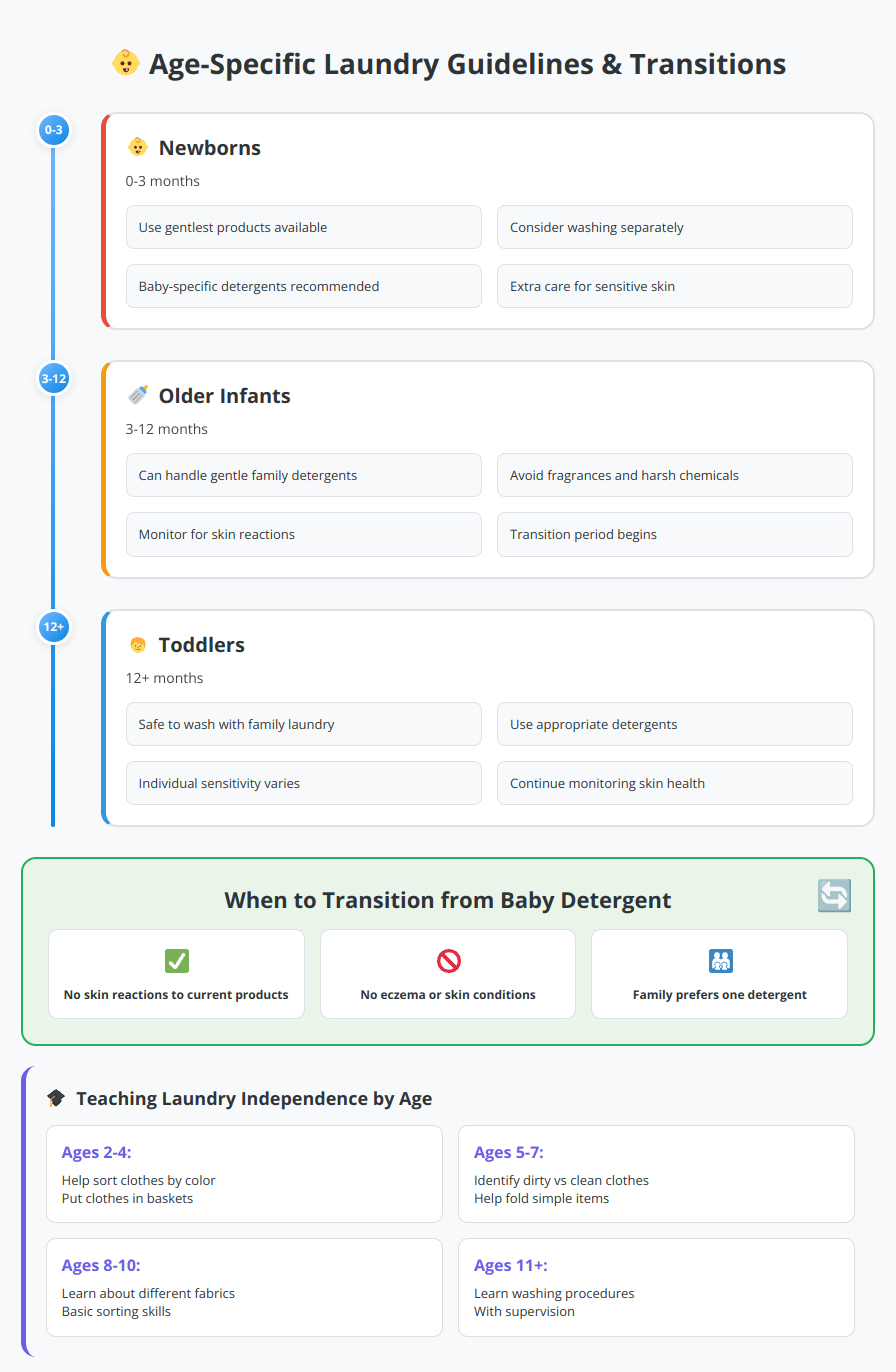
This timeline helps parents understand when to adjust their laundry practices as their child grows and develops greater skin resilience.
When to Start Using Regular Detergent
Parents often wonder, “At what age should I stop using baby detergent?” Most families can transition to regular, gentle detergents around 6-12 months, but this varies based on individual skin sensitivity.
Signs your child may be ready for regular detergent:
- No history of skin reactions to current products
- No eczema or other skin conditions
- Comfortable with current laundry routine
- Family prefers using one detergent for everyone
The transition doesn’t have to be immediate. Many families continue using gentle, fragrance-free detergents for everyone’s benefit, especially when family members have sensitive skin.
Newborn vs. Toddler Considerations
- For newborns (0-3 months): Use the gentlest products available and consider washing separately until skin develops more resilience. Newborn clothing requires extra care due to extremely sensitive skin.
- For older infants (3-12 months): Can usually handle gentle family detergents, but continue avoiding fragrances and harsh chemicals.
- For toddlers (12+ months): Generally safe to wash with family laundry using appropriate detergents, though individual sensitivity varies.
Teaching Independence and Safety
Around age 6-8, children can begin learning basic laundry safety, though they shouldn’t handle detergents or operate machines independently until much older.
Age-appropriate laundry involvement:
- Ages 2-4: Help sort clothes by color, put clothes in baskets
- Ages 5-7: Learn to identify dirty vs. clean clothes, help fold simple items
- Ages 8-10: Begin learning about different fabrics and basic sorting
- Ages 11+: Start learning actual washing procedures with supervision
Always maintain safety measures regardless of children’s age, keeping detergents locked away and teaching the importance of never playing with laundry products.
Managing Mixed Laundry Items Safely
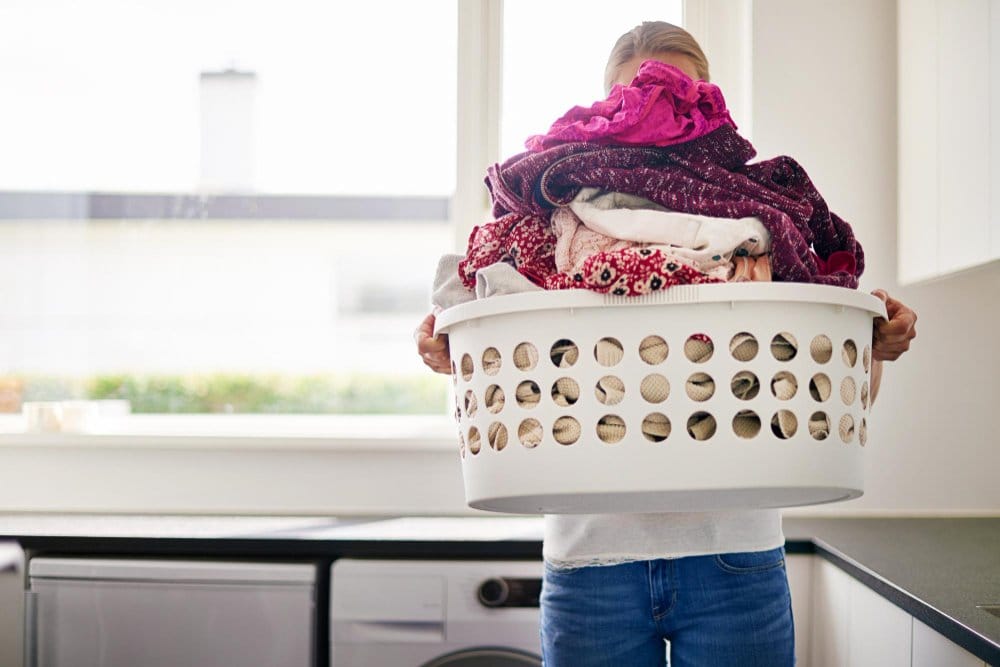
Towels and Linens with Toddler Clothes
Washing towels separately from toddler clothes is generally preferable. Towels often carry more bacteria and can produce lint that sticks to clothes, especially those made from soft fabrics common in children’s clothing.
Towels also require more water and longer drying cycles. Mixing them with lightweight toddler clothes can create uneven drying and may leave some items damp, which can lead to mildew or unpleasant odors.
If combining towels with toddler clothes:
- Use gentle cycle with hot water (if safe for both fabric types)
- Shake out towels to minimize lint transfer
- Ensure adequate space in washer for proper cleaning
- Use longer drying time or separate drying cycles
School Uniforms and Active Wear
School uniforms and sports clothing may have different fabric requirements than everyday toddler clothes. Some uniforms use synthetic materials that can trap odors and may need longer rinse cycles or specialized detergents.
Before washing, check care labels for both uniforms and children’s clothes to ensure compatibility. Turn uniforms inside out and zip any zippers to prevent rough fabrics from damaging softer toddler clothing.
For stained uniforms with grass or food marks, pre-treat with mild stain remover before washing. To prevent color bleeding, wash uniforms with similar colors when possible while avoiding strong detergents that might irritate toddler skin.
Comprehensive FAQ Section
Can I wash my kids’ clothes with my clothes?
Yes, you can safely wash children’s clothes with adult clothing when using gentle, fragrance-free detergents suitable for sensitive skin. Avoid mixing heavily soiled work clothes or sports gear with children’s items.
Is it okay to wash my baby’s clothes with mine?
For babies under 6 months, consider washing separately using baby-specific detergents to protect extremely sensitive skin. After 6 months, most babies can handle gentle family detergents safely.
Can I wash my 2-year-old clothes with regular detergent?
Two-year-olds can typically handle regular detergent, but choose “free and clear” formulations without fragrances or dyes. Monitor for any skin reactions and switch to gentler products if irritation occurs.
Should toddler clothes be washed separately?
Toddler clothes don’t always need separate washing. Combine with family laundry using appropriate detergents, but wash separately when items are heavily soiled or when family members are sick.
What clothes shouldn’t be washed together?
Never wash together: cloth diapers with regular clothes, heavily soiled work clothes with children’s items, clothes from sick family members with others, or items requiring different temperature settings.
Do I need a separate washing machine for baby clothes?
No, a separate washing machine isn’t necessary. Use appropriate detergents and washing techniques to safely clean baby and family clothes in the same machine.
What to avoid with baby clothes?
Avoid fabric softeners, bleach, strong fragrances, and dyes. Don’t use excessive detergent amounts or wash with heavily contaminated adult clothing.
Do I need to wash baby clothes after buying them?
Yes, always wash new baby clothes before first use to remove manufacturing chemicals, dust, and potential irritants from the fabric.
Is it safe to wash clothes with other people?
Yes, when family members are healthy and using appropriate detergents. Avoid sharing loads with sick individuals or those with contagious skin conditions.
At what age should I stop using baby detergent?
Most families transition around 6-12 months, but continue baby detergent longer if your child has sensitive skin, eczema, or allergies. Some families use gentle detergents permanently.
Can you use fabric softener on baby clothes?
No, avoid fabric softener on baby and toddler clothes. It can irritate sensitive skin and reduce the effectiveness of flame-resistant treatments on sleepwear.
Should I turn baby clothes inside out when washing?
Turning clothes inside out helps protect prints and delicate decorations, but it’s not necessary for basic cleaning. Do this for special items or clothes with decorative elements.
When can you stop washing babies’ clothes separately?
Most families can stop washing separately around 6-12 months when using gentle detergents, though individual skin sensitivity may require longer separation.
What clothes need to be washed separately?
Wash separately: cloth diapers, heavily soiled items, clothes from sick family members, new clothes before first wear, and items requiring special temperature or chemical treatments.
Product Comparison and Recommendations
2025 Top-Rated Family-Safe Detergents
Choosing the right detergent for mixed family loads requires comparing effectiveness, safety, and value across top-rated options.
🧴 Top-Rated Family-Safe Detergent Comparison 2025
- Child has diagnosed eczema or allergies
- Family history of sensitive skin
- Using cloth diapers
- Pediatrician recommends specialized products
- Child shows no skin sensitivity
- Family prefers one product for everyone
- Budget considerations important
- No special skin care needs exist
These recommendations are based on 2025 testing results, dermatologist reviews, and real parent feedback to help families make informed decisions.
When to Choose Specialized Products
Consider baby-specific detergents when:
- Your child has diagnosed eczema or skin allergies
- Family history of sensitive skin reactions
- Using cloth diapers that need gentle treatment
- Pediatrician recommends specialized products
Switch to regular gentle detergents when:
- Child shows no skin sensitivity issues
- Family prefers using one product for everyone
- Budget considerations favor larger family sizes
- No special skin care needs exist
Conclusion
Washing toddler clothes with adult laundry is not only safe but practical for busy families when done correctly. The key to success lies in choosing appropriate detergents, following smart washing practices, and prioritizing safety in the laundry room.
Essential takeaways for safe family laundry
- Product Selection: Choose gentle, fragrance-free detergents labeled “free and clear” that work effectively for both adult and children’s clothing. Products like Babyganics, Tide Free & Gentle, and Seventh Generation Free & Clear offer excellent options for mixed family loads.
- Safety First: Implement critical safety measures including locked cabinets for all detergents, avoiding dangerous laundry pods around young children, and keeping the National Poison Help Line (1-800-222-1222) easily accessible. Nearly 70% of child poisonings occur at home, making laundry room safety essential.
- Smart Washing Practices: Separate heavily soiled items, use appropriate water temperatures, and consider extra rinse cycles for sensitive skin. Avoid fabric softeners with children’s clothing and always pre-treat stains promptly for best results.
- Age-Appropriate Transitions: Most families can safely combine loads by 6-12 months using gentle detergents, though individual skin sensitivity may require longer use of baby-specific products. Monitor your child’s skin for any reactions and adjust accordingly.
- Special Considerations: Always wash cloth diapers separately, keep sick family members’ clothing isolated, and maintain proper sorting practices to prevent cross-contamination. New clothes should always be washed before first use.
The convenience of combined family laundry loads saves significant time and energy while maintaining safety when proper precautions are followed. By choosing appropriate products, implementing safety measures, and following expert-recommended practices, parents can confidently wash toddler and adult clothes together while protecting their children’s sensitive skin and overall health.
Remember that every child’s skin is different, so monitor for any reactions and be prepared to adjust your approach based on individual needs. When in doubt, consult with your pediatrician about the best laundry practices for your specific situation.


